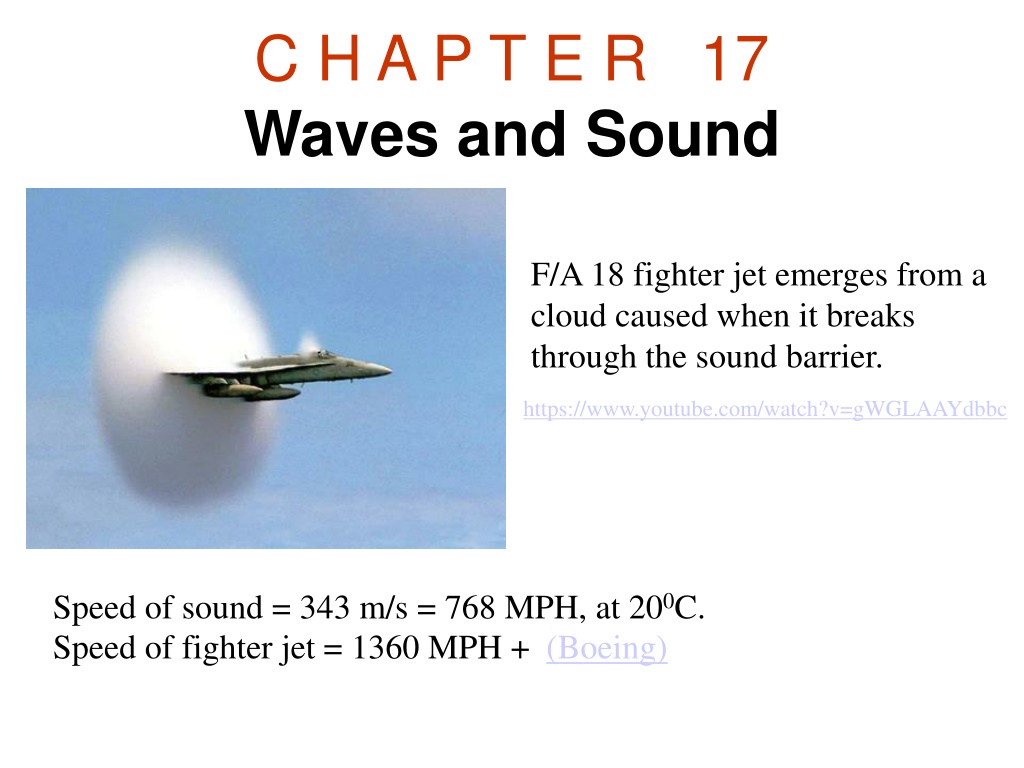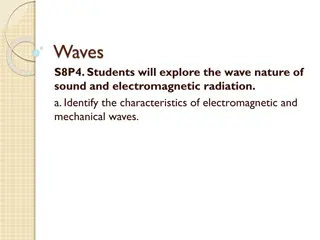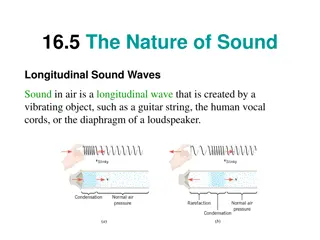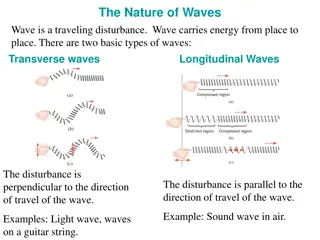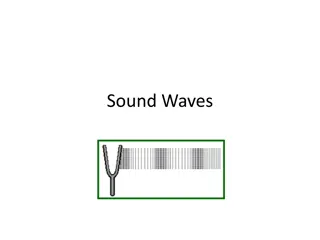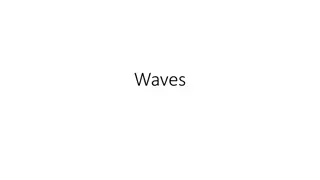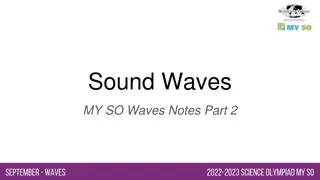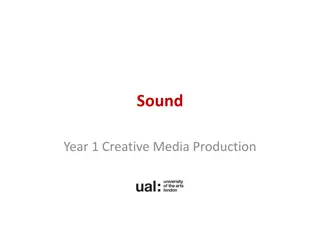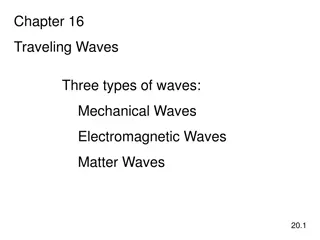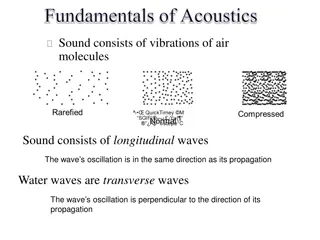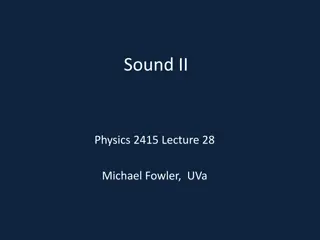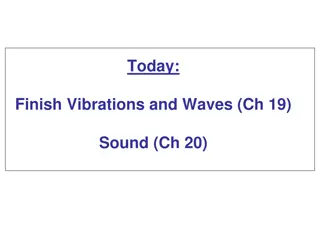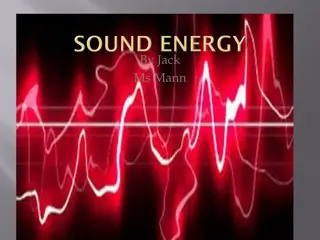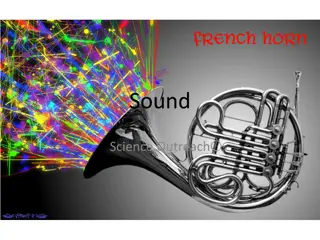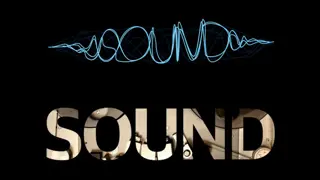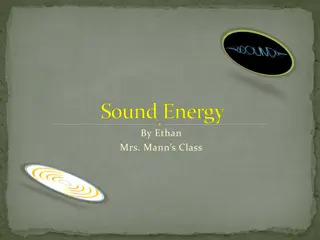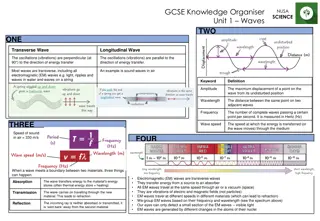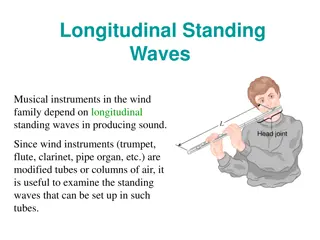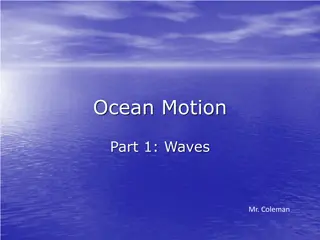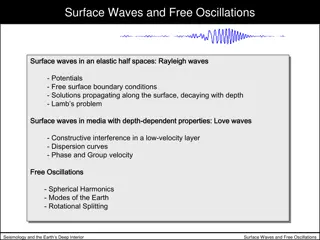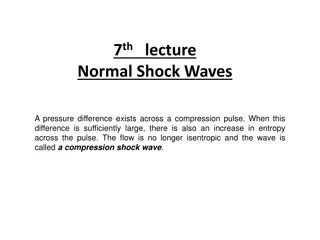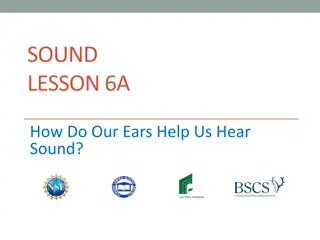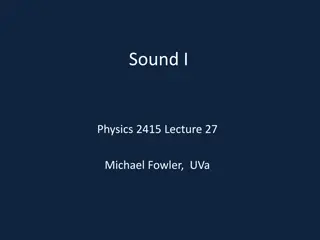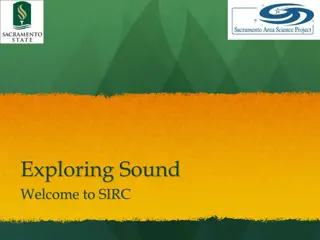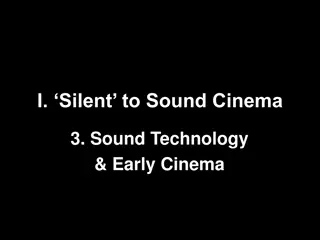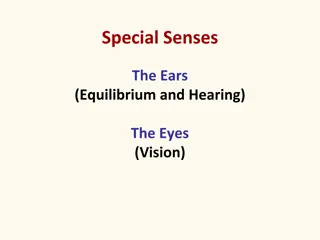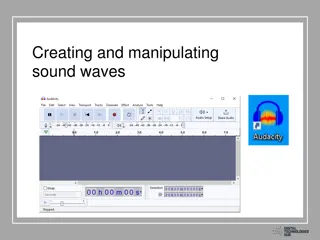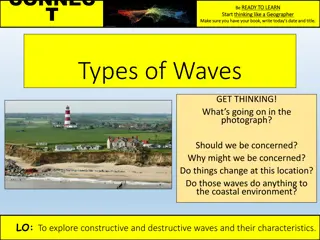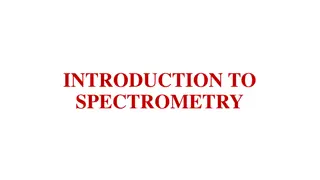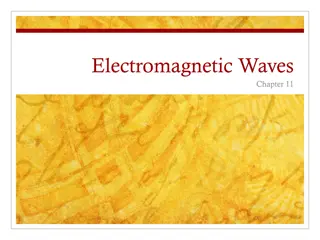Understanding Waves and Sound: A Visual Exploration
Explore the nature of waves and sound through a visual journey covering topics like transverse waves, longitudinal waves, water waves, periodic waves, wave speed, the speed of a wave on a string, the nature of sound, and the frequency of sound waves. Discover how waves carry energy, the different types of waves, and how sound waves are created by vibrating objects. Delve into the audible range of sound frequencies, from infrasonic to ultrasonic waves, and learn about the mechanisms of hearing and wave propagation. Experience the fascinating world of waves and sound in an engaging format.
Download Presentation

Please find below an Image/Link to download the presentation.
The content on the website is provided AS IS for your information and personal use only. It may not be sold, licensed, or shared on other websites without obtaining consent from the author. Download presentation by click this link. If you encounter any issues during the download, it is possible that the publisher has removed the file from their server.
E N D
Presentation Transcript
C H A P T E R 17 Waves and Sound F/A 18 fighter jet emerges from a cloud caused when it breaks through the sound barrier. https://www.youtube.com/watch?v=gWGLAAYdbbc Speed of sound = 343 m/s = 768 MPH, at 200C. Speed of fighter jet = 1360 MPH +(Boeing)
The Nature of Waves Wave is a traveling disturbance. Wave carries energy from place to place. There are two basic types of waves: Transverse waves Longitudinal Waves The disturbance is perpendicular to the direction of travel of the wave. The disturbance is parallel to the direction of travel of the wave. Example: Sound wave in air. Examples: Light wave, waves on a guitar string.
Water Waves Water waves are partly transverse and longitudinal. Dominoe Toppling: Human wave at a sport stadium:
Periodic Waves: waves that repeat The amplitude, A is the maximum disturbance. The wavelength, is the horizontal length of one cycle of the wave. The period, T is the time required for one complete up/down cycle of the wave. The frequency, f is the number of waves per unit time, f=1/T. Wave Speed =
The Speed of a Wave on a String T T = Tension provided by the hanging mass ? = v = ???? ????? , of the string.
The Nature of Sound Longitudinal Sound Waves Sound in air is a longitudinal wave that is created by a vibrating object, such as a guitar string, the human vocal cords, or the diaphragm of a loudspeaker. Sound cannot propagate in a vacuum. Bell in a vacuum
The Frequency of a Sound Wave Audible Range: 20 Hz ----- 20,000 Hz. Infrasonic waves: Sound waves with frequencies < 20 Hz. Rhinoceroses use infrasonic frequencies as low as 5 Hz to call one another Ultrasonic waves: Sound waves with frequencies > 20,000 Hz. Bats use ultrasonic frequencies up to 100 kHz for locating their food sources and navigating.
Objective and Subjective properties of sound Objective properties can be measured, used in physics. Subjective properties are subjective to the person, used in music. Objective property Subjective quality Frequency Pitch Intensity Loudness Waveform Tymbre or Quality
Speed of Sound in an ideal gas = 1.40 (ratio of specific heats for air) m = 4.8 x 10-26 kg (average molecular mass of air) k = 1.38 x 10-23 J/K (Boltzmann constant) T= temperature in Kelvin kT = v m Gases Speed of Sound (m/s) Liquids Speed of Sound (m/s) Solids Speed of Sound (m/s) Air (0 C) 331 Chloroform (20 C) 1004 Copper 5010 Air (20 C) 343 Ethyl alcohol (20 C) 1162 Glass (Pyrex) 5640 Carbon dioxide (0 C) 259 Mercury (20 C) 1450 Lead 1960 Oxygen (0 C) 316 Fresh water (20 C) 1482 Steel 5960 Helium (0 C) 965 Seawater (20 C) 1522 Inhaling Helium and Sulfur Hexafluoride
Sound Intensity The sound intensity I is defined as the sound power P that passes perpendicularly through a surface divided by the area A of that surface: The unit of sound intensity is power per unit area, or W/m2.
Human Ear and Sensitivity Audible frequency range: 20 Hz 20,000 Hz Audible intensity range: 10 12 W/m2 - 10 w/m2 10 12 W/m2 = Threshold of hearing 10 W/m2 = Threshold of pain
Decibels The decibel (dB) is a measurement unit used when comparing two sound intensities. The intensity level (expressed in decibels) relative to the threshold of hearing, Io is defined as follows:
Typical Sound Intensities and Intensity Levels Relative to the Threshold of Hearing Intensity Level (dB) Intensity I (W/m2) Threshold of hearing 1.0 10-12 0 Rustling leaves 1.0 10-11 10 Whisper 1.0 10-10 20 Normal conversation (1 meter) 3.2 10-6 65 Inside car in city traffic 1.0 10-4 80 Car without muffler 1.0 10-2 100 Live rock concert 1.0 120 Threshold of pain 10 130
Sonic Boom https://www.youtube.com/watch?v=1pf-Is2S1_Q&t
The Doppler Effect The Doppler effect is the change in frequency or pitch of a wave for an observer moving relative to its source.
Source Moving Towards Observer v . = f f o s v v s
Source Moving v . = f f o s v v s vs .when the source moves towards the observer. +vs . when the source moves away from the observer.
Moving Observer + v v = . o f f o s v
Moving Observer v v = . o f f o s v In the above equation +vo is used when the observer moves towards the source and vo is used when the observer moves away from the source.
Doppler Effect General Case = s o v v v . o f f v s +vo is used when the observer moves towards the source, vo is used when the observer moves away from the source, vs is used when the source moves towards the observer, and +vs is used when the source moves away from the observer.
Application of Doppler Effect Nexrad: Next Generation Weather Radar
Applications of Sound in Medicine 1. Ultrasonic Scanner 2. The cavitron ultrasonic surgical aspirator (CUSA) 3. Bloodless surgery: High-intensity focused ultrasound (HIFU) 4. The Doppler flow meter
The cavitron ultrasonic surgical aspirator (CUSA) Neurosurgeons use a cavitron ultrasonic surgical aspirator (CUSA) to cut out brain tumors without adversely affecting the surrounding healthy tissue.
Bloodless surgery High-intensity focused ultrasound (HIFU) Another application of ultrasound is in a new type of bloodless surgery, which can eliminate abnormal cells, such as those in benign hyperplasia of the prostate gland. This technique is known as HIFU (high-intensity focused ultrasound). It is analogous to focusing the sun s electromagnetic waves by using a magnifying glass and producing a small region where the energy carried by the waves can cause localized heating. Ultrasonic waves can be used in a similar fashion. The waves enter directly through the skin and come into focus inside the body over a region that is sufficiently well defined to be surgically useful. Within this region the energy of the waves causes localized heating, leading to a temperature of about 56 C (normal body temperature is 37 C), which is sufficient to kill abnormal cells. The killed cells are eventually removed by the body s natural processes.
Doppler Flow Meter A Doppler flow meter measures the speed of red blood cells.
